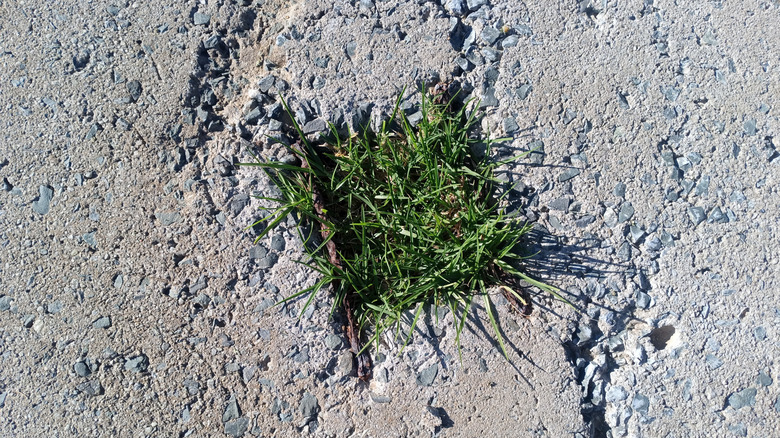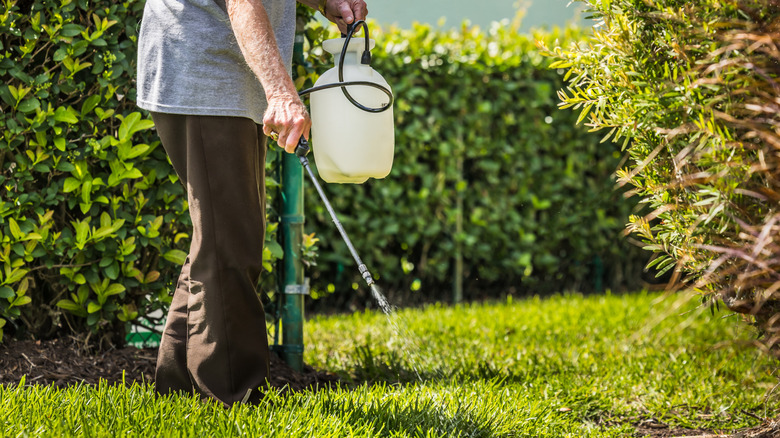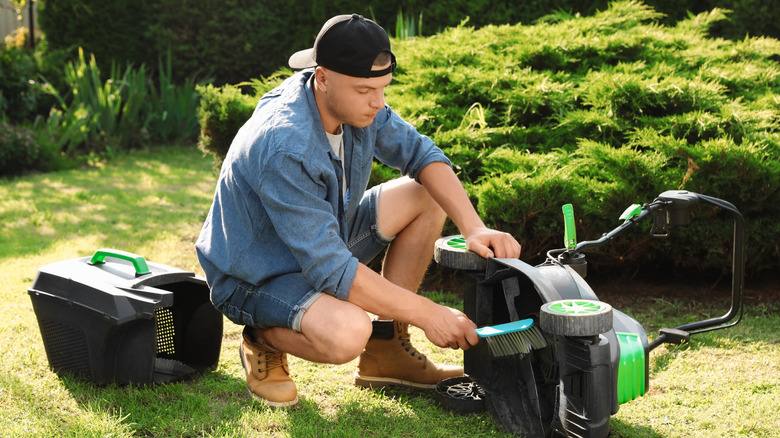The Best Way To Handle Annoying Goosegrass Growing In Your Yard
If you're seeing patches of coarse, weedy grass creeping into high-traffic areas like along the driveway or across your lawn, goosegrass might be to blame. This stubborn weed often shows up where the lawn is already under stress. It typically appears in mid to late spring and forms a pale green patch. The plant dies off after the first frost, but seeds dropped in late summer can easily sprout the following spring under favorable conditions. Mature goosegrass plants can spread up to 2 ½ feet in width. That's why it's important to tackle problem areas early and create conditions that help kill goosegrass before it can spread.
Start by addressing the areas where goosegrass is most likely to appear. Use a core aerator to loosen compacted soil and improve drainage, giving your lawn a better chance to recover and grow stronger. In high-traffic zones, consider redirecting foot traffic with a stepping stone path to reduce wear and tear. Maintaining a consistent routine of mowing, fertilizing, and pest control will also help your grass grow thicker and crowd out potential weeds like goosegrass.
Once your lawn is on the mend, you can tackle the goosegrass that's already growing. It has a single consolidated root system, which makes smaller plants easier to pull by hand. For larger weeds measuring 2 to 3 inches across, a garden knife or deep-rooted weed removal tool can help lift them out more effectively. It is one of the easiest ways to deweed your garden, but this method only works well if you're dealing with a few patches. You may need to turn to herbicides for bigger infestations.
Effective herbicide options for mature goosegrass
Once goosegrass breaks through, post-emergence herbicides become your best option for control – but you should be careful to follow the exact instructions on the back of the label of any chemical product that you use. A number of herbicides are designed to target grassy weeds specifically, while leaving other plants unharmed. However, choosing the right product also depends on how far the weed has developed. Smaller goosegrass plants usually respond well to contact herbicides, which work best when sprayed directly on the leaves. But once the weeds grow larger and root more deeply, those surface treatments lose their edge. At that point, systemic herbicides, formulated to travel through the plant's internal system, offer better results.
If goosegrass continues to thrive despite treatment, herbicide resistance may be the reason. A few signs to look for include patches of goosegrass that survive while other weeds are controlled, no visible herbicide damage on treated plants, or repeated failure of the same product in the same area. If you suspect resistance, avoid using the same product again and reach out to a local nursery or expert gardener for guidance. In the meantime, avoid using the same product repeatedly. Switching between different types of herbicides each season can also help maintain control and keep goosegrass from adapting. Moreover, moisture levels can also influence how well some herbicides work. Applying herbicides under dry, sunny conditions with low humidity may also improve results.
How to prevent goosegrass from spreading again
Keeping goosegrass out for good starts with making your lawn a difficult place for it to grow. Even after removal, seeds can easily spread by hitching a ride on lawn equipment, shoes, or pets, undoing all your hard work. Taking a few minutes to clean tools, mower blades, and footwear before moving between areas can go a long way in keeping treated spots free of new infestations. Alongside preventing spread, mowing habits also play a key role in keeping goosegrass out. Cutting your lawn at the proper height encourages thick, healthy turf that shades the soil and makes it harder for weed seeds to sprout.
On the other hand, cutting the grass too short can weaken the lawn, leaving thin, bare patches where weeds like goosegrass can easily move in. While the ideal height varies by grass type, sticking to the recommended range helps your lawn stay thick, resilient, and more resistant to weed invasions. To round out your lawn care strategy, overseeding thin or bare patches helps build the density needed to keep weeds like goosegrass from taking hold. As new grass fills in the gaps, it reduces open space and competition for light, water, and nutrients, making it harder for weeds to take hold.


